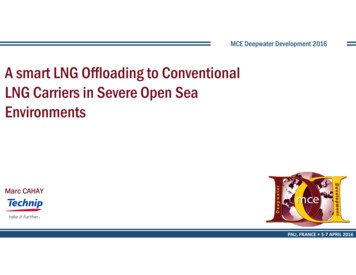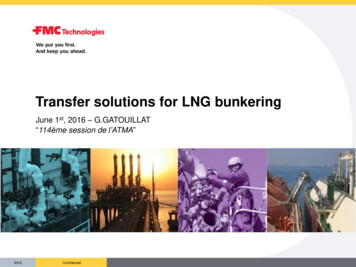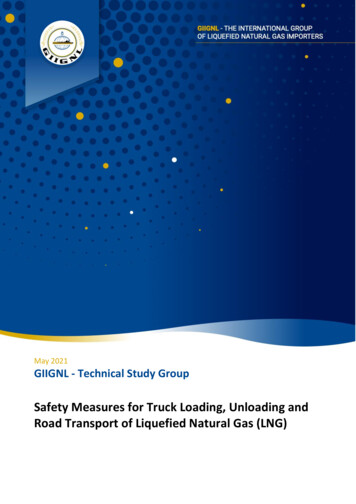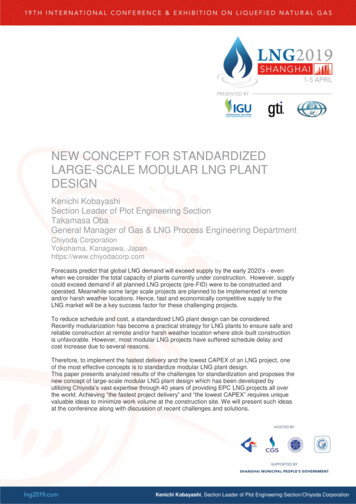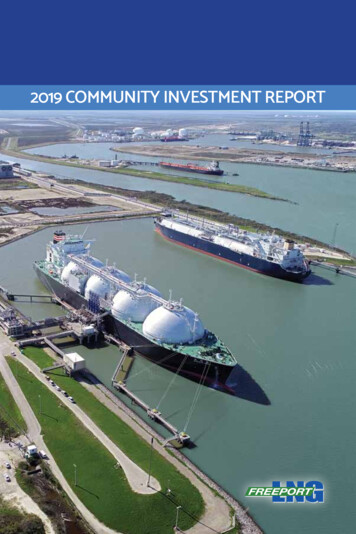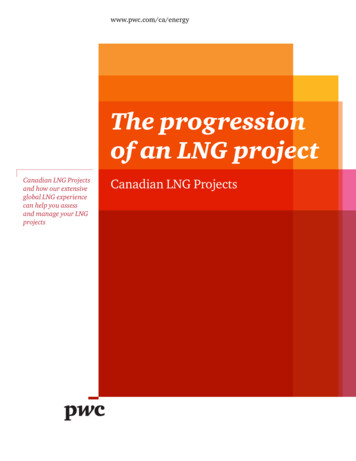
Transcription
www.pwc.com/ca/energyThe progressionof an LNG projectCanadian LNG Projectsand how our extensiveglobal LNG experiencecan help you assessand manage your LNGprojectsCanadian LNG Projects
Canadian LNG projectsApproved Canadian LNG export projects(listed in order of NEB filing status)Proposed start dateNEB approvalKitimat LNGProjectPlanned capacity (mtpa)102017ApprovedBC LNG Export Cooperative (Douglas Channel)1.82015ApprovedLNG Canada242019ApprovedPacific Northwest LNG122019ApprovedWest Coast Canada LNG302021–2023ApprovedPrince Rupert LNG322020ApprovedWoodfibre LNG2.12017–2021ApprovedTriton LNG2.32017ApprovedAurora LNG122021–2023ApprovedTo date, two further projects involve export of gas to the U.S. and nine further projects are pending with the NEB.Source: National Energy BoardPwC Canada has extensive local and global experience to helpjoint venture partners to select, evaluate and progress withtheir investment choice.
LNG: An overview of growthLiquefied natural gas has become an important part of theglobal energy supply chain. Currently representing just over10% of natural gas volumes delivered, LNG is now exported by18 countries and imported by 27. Many more are preparing orconsidering both exports and imports.Canada is new to the LNG sector, one of thecountries presently gearing up to exportproduct to Asia, and perhaps beyond. Overthe last few years, and more particularly in thepast year, export licenses have been granted bythe Canadian National Energy Board to severalLNG developers.This sudden surge in project developmenthas been brought about by changes onglobal demand, market changes in NorthAmerica and abundant natural gas resourceavailability in Western Canada. These factorshave combined to boost an emerging industrythat will compete for market share with otherestablished producers or new entrants.The majority of the LNG projects with exportlicenses are West Coast based, taking advantageof the relative proximity of British Columbia’sshale gas basins, an integrated North Americangas market and the relatively short distance tothe Asian market.With a global supply gap forecast ofapproximately 150 million tonnes per annum(mtpa) by 2025, Canada’s planned LNG projectcapacities total more than that amount. Theconclusion would be that not all the Canadiandevelopments will successfully move forward.
The major Canadian projects are mainlyintegrated, meaning the feedgas supply comesfrom within the consortium that developsthe LNG project. This is in contrast to the USapproach where the gas is sourced from theopen market and a tolling fee is charged toliquefy it.For joint venture partners, evaluating andselecting the right project then becomes amatter of some importance. Certain uniqueelements, like consultation and participationwith First Nations and familiarity with thevarious gas formations make the CanadianLNG industry somewhat different from otherjurisdictions.PwC Canada has assisted several jointventure partners with an appreciation andunderstanding of these unique characteristicsof the Canadian LNG sector and advised thosepartners how to execute the business plan andavoid potential issues in the future.
The timeline, levelof effort and costBroadly, for Canadian LNG projects theseevents and activities fall into two distinctproject phases: pre-Final Investment Decision(FID); and post-FID. Whereas an owner hasto follow the sequence in its entirety, a jointventure partner can opt in at several points.PwC is able to assist with both the pre- andpost-FID activities and help you consider therisks and rewards that accompany a majorLNG project. Unlike many other capitalprojects in the oil and gas industry, theseprojects must spend a considerable amountof time, effort and money before the finalinvestment decision is made.Breaking down what’s involvedin an LNG projectThe complexity of major LNG projects is reflected in their timescales to completion. It is not unusual for an elapsed time of10 years between inception and first gas delivery, especiallywhen greenfield projects are contemplated, where no previousinfrastructure exists to shorten the construction period.The elapsed time is roughly equally split betweenpre- and post-Final Investment Decision:1 yearFeasibility2 years2 yearsPre FEEDFEED5 yearsFIDConstructionFrom experience with actual projects, the level of effort andspending can also be approximately quantified as follows:PEAK STAFFING 200400–500500 6,000 Cost estimatesTens ofmillionsHundreds ofmillionsBillionsTens ofbillionsFIDFeasibilityPre FEEDFEEDFID ConstructionAs a rule of thumb 1 trillion cubic foot (tcf) of provengas reserves is required for every 1 million tonnes perannum (mtpa) liquefied for a 20 year period.Evaluating a potential LNG project isa difficult undertaking. Historically,completed LNG projects have beencomplex, reliable, operationally sound,profitable, but always very challengingto move from inception to operation. Notwo are the same, as the commercial andtechnical aspects vary from project toproject and from country to country.However, it is possible to break down thesequence of events that must occur duringthe progression of the project and the majorinputs that contribute to the final decisionsand results. This systematic approach isrequired to ensure confidence in the project,as each segment of the LNG value chain isplanned, assessed and sanctioned.
The progression of an LNG projectPre-FIDPost-FIDThe lines of inquiry that might accompany each pre-FID activity could include the following types of questions and topics:Similar topics for the post-FID activities might include these types of questions and topics for consideration:Feasibility: is the Memorandum of Commerciality: Markets: whatPre Front Endinitial idea sound and can Understanding: what structure will itare seen as the possibleEngineeringa value chain be built?take to make moneymarkets and sales prices? Design (FEED):establishing the basicand defer risk?parameters for partnersprogression of technicalto proceedwork to the next levelof detailPermits: what are Location: wherethe legal, regulatory and exactly can we site thepermitting requirements? marine and onshorefacilities for the project?“Has the right project“What are theunavoidable local issues structure and correctthat must be addressed?” range of partners beenchosen?”“Are there likely to be anysignificant changes in theregulatory or permittingprocesses?”“What local issues must be “Has the availability oftaken into consideration in drilling rigs to prove up gasthe choice of a suitable site reserves been examined?”for plant location?”“What exactly are thepermitting requirementsfor LNG in BritishColumbia?””How will the sitechosen affect the localcommunity goingforward?”“How can we achievethe lowest cost in theshortest schedule?”“How site specific are“Has the allocation of risk “What are the futurebetween the participating global LNG supply andour costs?”parties been satisfactorily demand characteristics?”achieved?”“How will the agreements “Do we understandoperate to create thethe tax and regulatoryvalue chain?”regime in place?”“ How will marketsevolve in the future?”“Stick built liquefactionplant or a modulardesign approach?”Reserves: can thecapacities be backed upby proven gas reserves?Sales andPurchaseAgreements(SPAs): initialEPC contracts:Drilling: providingexecute contracts awarded the production requiredpre-FID based on FEEDfor feedgasinputFinance: meetinglenders criteria forfinancingnot always an easy taskin Canada“What are the risksinvolved in the pricingformulae used in the SPAsto be signed?”“Are we confident thatthe FEED work willprovide enough detailedinformation for an FID?”“Do we have aninvestment gradeproject?”“When should FirstNations be first engagedand consulted overpipeline routes?”“Will the timing of thelong lead items delaythe project?”“How will the shortenedWestern Canadian drillingseason affect feed gasproduction and upstreamdevelopment?”“Do the SPAs ensurethat the project couldproceed?”“Have all the risks beensurfaced and addressed?”“What will be ouroverall cost offinancing?”“Should we own thepipeline, or not?”“Was the FEED worksufficient to tender theEPC contracts?”“What is the locallevel of acceptance offracking techniques andprocedures?”agreements with LNG offtakers to guarantee sales“Will the shale gas fieldsdeliver the productionvolumes required overthe time period to becontracted?”Pipeline build:FEED: engineeringwork to cost project foraccurate decision makingand tenderingConstruction:Utilities: mostlygreenfield builds andinstallations on theWest CoastMarineterminal: size,Liquefactionplant: major capitaltiming of construction ofcoastal facilitiesexpenditure and laborsourcing“What exactly will theconstruction and laborsituation be in WesternCanada in these remoteareas?”“How much power canthe local grid supply, ordo we have to generateour own?”“Should this be built earlyso that complete processunits can be shipped in?”“How can we ensure thatour schedule will be metand that we have all theright controls in place andworking correctly?”“What are the local“Will a breakwater orregulations and standards dredging be required forregarding utilitiesthe chosen site?”operation?”greenfield situation forCanadian LNG projectsCommissioning: Operations:Shipping: securing Regasification:standard post-buildprocedureslong term operationalcapability, in some caseswith train additionsLNG carriers and rates, ortaking delivery of custombuilt boatsend user facilities eitherexpansion of existing, ornew plants“What are the economicsof adding future trains?”“What are our risks atthis stage and can they bemitigated?”“Will the project runsuccessfully to ensuregeneration of revenues toservice debt and providereturns?”“What does the forwardmarket for LNG carrierslook like?”“Are we working withthe optimal tariffs forregasification?”“Do we have a finalassessment of theenvironmental andsocial impacts?”“Has the commissioningbeen carried outsatisfactorily to ensureefficient and effectivefuture operation?”“What is the best way toinclude local communitiesin the operation of theplant?”“What level of control over “Should the buyer or theshipping is most suitableseller take responsibility– charter, ownership orfor delivery?”avoid participation intransportation?”How we can help with pre-FID and post-FID activitiesPwC can also provide the following services for pre-FID and post-FID activitiesPwC’s experience in the LNG industry can be of assistance to developers or joint venture partners wanting to evaluateCanadian LNG projects. We have provided the following services to projects proponents on a global basis:PwC’s experience can be of assistance to developers or joint venture partners wanting to evaluate Canadian LNG projects.Commercial structuringand financingDue diligence andagreement negotiationsThe commercial structuring andfinancing of LNG import terminals andcompetitive tender for LNG supply. Thisinvolved: market analysis and evaluationof demand for gas; constructinga financial model of the proposedproject(s); economic assessmentof the value chain; risk mitigationrequirements for project financepurposes; presentation of projects toprospective lending banks/financialinstitutions; and financial structuring.The financial and tax due diligencein connection with an investment tofund the proposed development andconstruction of an LNG liquefactionterminal within an entity operatingexisting LNG regasification assets.Our work included evaluating forecastcash flows and working capitalrequirements; assessing the mechanicsof the financial model, including thecomplex domestic and internationaltax attributes; renegotiation of existingand preparation of new relatedparty agreements for operating andmaintenance services, managementservices and involvement withinvestment agreements.Tax structuringCarve-outInvestment advisoryProject assessmentLNG model due diligenceThe tax structuring analysis of anexisting LNG regasification seekingnew equity and debt financing to fundthe development and construction ofnew LNG liquefaction trains; providedthe accounting and tax restructuring,financial and tax due diligence inconnection with an investment in theproposed development.Analysis on behalf of new investorsinto an existing LNG business beingcarved out of a corporate parentinto a new entity which intends tobuild a new LNG liquefaction facility.Our work included analysis of thecarve-out, labor matters, financialand tax due diligence structuringand valuation of the assets to becontributed by the corporate parent.Support on the development of LNGstrategy in the context of expectedmarket development and tradingoptions. We compared and contrastedthe economics of alternativedevelopment schemes including thesizing of LNG regasification terminalsand a range of options for futurecapacity expansions; and undertooka market analysis of US and EuropeanLNG capacity, their expected futuredevelopment and commodityprice forecasts.External project advisory servicesin relation to the client’s worldwide LNG construction program,including assessments on projects inChina, the United Kingdom, Peru,Australia, Chile, and Angola thatwere in excess of 6B. Our workincluded a comprehensive review andimplementation of project controltools related to cost, time, and changecontrol; risk identification; scheduleanalysis and advice on opportunitiesfor performance improvement.PwC was engaged by a large publiclylisted energy company to performmodel due diligence on the financialmodel and supporting assumptionsdeveloped for the purpose of obtainingfinancing for the development ofits liquefaction facility. The modelincluded detailed cash flow andoperational forecasts for each ofthe natural gas liquefaction trainsassociated with the project, in additionto overlays for the proposed financingstructure and supporting credit metrics.Domestic taxcompliance andconsulting servicesWe can help better manage taxrisk through timely filings, reduceyour internal resources spend oncompliance, reduce your exposureto penalties, be abreast of themost relevant information andcontrol your compliance costs.Choosing theright dealOur deals team will help you makethe right acquisition that fits yourbusiness strategy. We’ll then assistwith determining the target anddeal structure, and setting up asolid agreement. Whether it’sentering Canada in a completecontrol capacity, pursuing nonoperating transactions, jointventures or a partnership, itrequires a strategic approach.International tax andstructuringOur international tax structuringprofessionals can help you tostructure your internationalbusiness in a tax efficient manner,both locally and globally. We canhelp you construct effective crossborder strategies and manageyour global structural tax rate.Valuations andpurchase priceallocationWith the largest in-houseactuarial practice of any Canadianprofessional services firm, we’llbe able to offer strong supportin determining the value of yourbusiness enterprises, interests,assets or liabilities. We can alsohelp develop economic modelsand estimate the fair value of yourassets, such as oil and gas reserves,resources and undeveloped land.Transfer pricingIndirect tax and GSTOur transfer pricing practicedraws from a global pool of 1,100professionals in more than 150countries to efficiently meet thecross-border tax challenges ofglobalization. We can help youestablish and document theappropriate Canadian transferpricing policies and evaluation oftolling structures.Our indirect tax professionals canassist in determining what taxesare imposed by a jurisdiction,whether the activities of acompany are enough to subjectit to the tax, and how to eitherstructure the company’s activitiesto eliminate the tax or assistin complying with the filingrequirements.IT infrastructureFinancial andoperationalaccountingWe can help you to select anaccounting information softwareplatform, develop vendorevaluations, establish fit forpurpose information systemsoperations, prepare estimates onlicensing and operational costs ofsoftware systems, establish effectiveinformation security practices tomitigate cybercrime risks, integratewith your existing corporatesystems and set up an informationarchitecture that enables efficientaccess to critical informationneeded for decision making.We’ll help you set up a master fileto manage both acquisitions andongoing transactions, integratecapital expenditure accountingwith tax reporting, and prepareand analyze your budget.Human resources services (HRS) and legalimmigration and expat personal tax issuesAccounting advisoryservicesWe can help ensure yourinternational assignment policiesare tax-compliant, meet the needs ofthe business and are cost-effective.We can also help you with yourmobility delivery structure, developcompetitive payroll, compensationand benefits packages, manage therisks associated with deploymentand help ensure you’re selectingthe right staff for an internationalassignment.We specialize in complexaccounting matters to help youdevelop a corporate response totechnical accounting developmentsincluding the transition to IFRSaccounting policies. We canhelp you evaluate and developaccounting policies for bothconventional and unconventionaloil and gas operations.IntegrationCapital projectmanagementWe can help you identify the criticalintegration points with your existingbusiness, create detailed actionplans to deliver value from thedeal, execute detailed integrationplans, and enhance cost reductionsthrough supply chain analysis.Achieving schedule, cost and safetygoals on major projects has neverbeen more important in terms ofthe market impact of failing tomeet major project milestones.As the scale and size of projectscontinue to increase, so do thefailure rates. Our capital projectsspecialists apply leading practicesand frameworks that can help youaddress challenges throughoutyour capital project and realize theoutcomes you set out to achieve.Market assessmentWe can help you understand thebusiness environment and strategicinvestment opportunities, bringyou a comprehensive overview ofthe issues, challenges and thoughtleadership specific to the Canadianenergy industry and connect youto networks and the right advisorssuch as lawyers and engineers.Supply chain managementCompanies need to manage thirdparty costs by transforming thesupply chain strategy, structure,process, people and technology,including categorizing externalspending across the company.This will achieve balancebetween third party and in-housecapability and drive value bybetter aligning the businessrequirements with suppliercapability and focusing onperformance. Effective categorymanagement also drivessustainable value and can createa higher level of compliance andvisibility to enable contracts andcommitments to be managedmore effectively.
There are multiple components to theLNG value chain and typically the spendproportions would be as indicated:RegasificationUpstream development20%10%LNG transportationLNG plant30%40%Examining the LNG Plant percentage, this might bebroken down as follows for a greenfield project:Loading/MarinePre-treatment10%6%LNG Storage18%Liquefaction50%Utilities16%Indicative Capex for integrated LNG project25%3%33%29%6%Pre-FID5%1Source: PFC Energy23Year45When the Canadian LNG projects are comparedto this matrix, we would suggest that theupstream percentage will be higher. This willoccur because of the need to feed the plants withshale gas from remote fields where little pipelineinfrastructure is in place and also to allow forthe high depletion rate of shale gas wells andsubsequent higher drilling budgets. On the otherhand LNG shipping costs will be lower as Asianmarkets are relatively close to the West Coast.Liquefaction then is only 20% of total projectcosts. A rule of thumb for Opex is 3% of Capexper annum.A leading energy consultancy company hasindicated that 6% of the Capex is spent pre-FID.So for a 30 billion project, 1.8 billion will bespent before a final decision to proceed is made.This is followed by the first year of construction,mainly procurement effort and hence only 5%of the project cost.
Our LNG experiencePwC has LNG experience in many countries around the globeCanada Performed due diligence on the financialmodel and supporting assumptions developedby the company for the purpose of obtaining over 4 billion in financing for the development of aliquefaction project. The model included detailedcash flow and operational forecasts for each of thenatural gas liquefaction trains associated with theproject, in addition to overlays for the proposedfinancing structure and supporting credit metrics.Canada Assisted a large multinational in itsacquisition of a 10% interest in gas assets andparticipation in a planned LNG facility in BC.Our involvement included financial modeling,valuation market comparisons, financial andtax transaction assistance and diligence, taxstructuring, assistance with leading practice interms of accounting procedures for joint ventureagreements, IFRS accounting advice for proposedtransaction, and transaction and agreement advice.Canada Developed a financial model to assist theclient in assessing a contemplated acquisition ofan interest in Canadian shale gas assets and theproposed LNG export terminal.Canada LNG modelling, accounting and taxservices for various proposed pre-FID investors.North America Advisor on LNG from Russia toUS and Canada. It involved a feasibility study andproject structuring to enable finance-raising. Theareas covered included: LNG liquefaction, shipping,regasification and gas marketing.Colombia Served as a lead advisor to a consortiumof utilities developing the first liquefied natural gasregasification terminal in Colombia. Provided advicethroughout the tender and procurement process,including: proposed enhancements to the terms ofreference; performed a comparative risk analysisof proposed facility configurations focusing onrisks to meeting commercial operation date andto maintaining operational reliability/availability;conducted bidder interviews; identifying risksrelated to each technical proposal; and supportedcontract negotiations.Peru Provided observations and recommendationsfor the development of project management toolsand procedures where current gaps exist and maderecommendations for changes or improvements toprocesses and/or controls where appropriate at theliquefaction plant and marine facilities.Chile For the owners, validated time and costprojections and conducted an analysis of theoutturn cost forecast and likely profit or lossposition at an LNG regasification and send-outsystem, including marine jetty with complete shipunloading facilities and storage tanks.Wales Advice on the gas transportationinfrastructure implications of locating LNG terminalsin Wales and the identification of gas transportationinfrastructure investment requirements andcalculation of tariff implications of additionalinvestment.Wales Assessment of risk at an LNG regasificationplant, jetty and shiploading facilities as it relatedto engineering, procurement, construction andcommissioning of the terminal system works,encompassing civil, mechanical, piping, structural,buildings, and electrical and instrumentation work.UK Commercial structuring advice to an LNGregasification project development company,assisting them to evaluate the advantagesand disadvantages of selecting a downstreamparticipant for the project, while considering theoverall process for selection, and analysing thevarious options for structuring the company’sparticipation in the project.UK Provided advice on project structuring foran LNG facility, including review of joint ventureagreement and evaluation of commercial driversfor each party to the agreement.UK Lead advisor to an oil-products storagecompany, evaluating a greenfield LNG importfacility in the UK.US Provided continuous external projectassessment services to a major EPCvendor in relation to its global LNGconstruction program.Algeria, US, UK Investment advice to amajor international energy company on thedevelopment of a multinational LNG project,including evaluation of alternative developmentschemes, LNG regasification terminal sizing andlocation, arbitrage evaluation, and analysis ofUS and Europe market capacity and prices.Middle East, Europe, US Investment adviceto a major international energy company on thedevelopment of a multinational LNG project. Theassignment included evaluation of alternativedevelopment schemes, LNG regasificationterminal sizing, contract advice for further capacityexpansions, analysis of US and Europe marketcapacity and prices, and valuation of portfoliooptions for LNG swaps.
Italy Investment advice to a major internationalenergy company on the development of aregasification terminal and downstream businessin Italy, involving assessment of the developmentof the market, and valuation of various contractschemes for the terminal, i.e. tolling arrangement,integrated value chain.Lithuania Preparation of a feasibility studyfor the development of the country’s first LNGimport terminal, involving feasibility analysis froma technical, environmental, legal, commercial,demand-side and supply-side perspective andincluded providing a road-map for the subsequentdevelopment of the project.China Provided project assessments at aregasification import terminal related to projectcontrol tools implemented on projects with respectto cost, time and change control to identify areasof risk and advice on opportunities for performanceimprovement.Middle East, India Investment advice to a majorinternational energy company on the developmentof a multinational LNG project, including riskassessment of end user market in India, LNGregasification terminal capacity and upgrade sizing,and optimal upstream supply from various LNGproduction alternatives in the Middle East.Oman, Nigeria, Australia Assessment of gasreserve quantities and commercial arrangementsfor a number of LNG feedstock contracts.Egypt Lead advisor to an LNG company for theexport of LNG from Egypt to Europe. Completed afeasibility study developing the entire value chainfrom upstream gas production to liquefaction,shipping, LNG regasification and gas marketing.The assignment included commercial structuring,partner selection and raising finance.Angola Reviewed tools and procedures inplace on LNG projects to monitor adherence tocontract requirements and to manage projectrisk highlighting strengths and potential gapsin the existing systems and controls. Provideperiodic inspection to ensure that risk is beingproperly managed and mitigated through theproject life-cycle.Australia Valuation of a proposed LNG projectdevelopment to support a proposed bid for aninterest in the project.Australia Valuation assessment of a major LNGproject for tax purposes relating to a restructureof the project.Australia Fair market valuation assessment ofan LNG project for the purposes of assessing thestarting base value of the project on transitioninto the petroleum resource rent tax (PRRT)regime.Australia Review of a financial model of a majorLNG project on behalf of an LNG customer whichacquired an equity interest in the LNG project.Review of PRRT modeling to assess the deferredtax asset that is to be booked by a projectparticipant in relation to un-deducted historicalexpenditure as a result of a final investment decisionfor the development of the LNG project.Australia Valuation of a proposed coal seam gasLNG project development on transition into thePRRT regime which was extended to onshore oiland gas projects.Australia Review of a financial model of an LNGproject for valuation and reserve reporting.Australia Development of a financial model foran LNG project on behalf of the project operator,including the assessment of the impact ofalternative project structures as well as proposedchanges in the applicable tax and regulatoryregimes to support investment decision making.
Our expertsFor a discussion on opportunities around LNG in Canada, please contact:General inquiriesAudit and Assurance servicesConsulting servicesReynold TetzlaffShannon RyhorchukMatthew WetmoreNational Energy LeaderCalgary AAG Site LeaderCalgary Consulting Leader403 509 7520reynold.a.tetzlaff@ca.pwc.com403 509 7506shannon.g.ryhorchuk@ca.pwc.com403 509 7483matthew.b.wetmore@ca.pwc.comCalvin JacoberJohn Paul PresseyMichel GrillotCalgary Managing PartnerVancouver AAG Site LeaderPartner403 509 7531calvin.b.jacober@ca.pwc.com604 806 7097john.paul.pressey@ca.pwc.com403 509 7565michel.grillot@ca.pwc.comJohn DeLucchiManaging Partner, BC Region604 806 7575john.delucchi@ca.pwc.comAccounting Advisory servicesTax servicesDomenico BaruffaldiNational Energy Tax Leader403 509 6676domenico.baruffaldi@ca.pwc.comJames McLeanPartner, Operations and Supply Chain403 509 7535james.mclean@ca.pwc.comOwen TaylorPartnerDavid WhiteleyAngelo ToselliPartnerCalgary Tax Leader403 509 6653david.c.whiteley@ca.pwc.com403 509 7581angelo.f.toselli@ca.pwc.comScott BanduraJason DurkinClinton RobertsPartnerAlberta International Tax Services LeaderCalgary Deals Leader403 509 6659scott.bandura@ca.pwc.com403 509 7598jason.d.durkin@ca.pwc.com403 509 7307clinton.l.roberts@ca.pwc.comBrad SakichPaul SharpPartnerPartner, Valuations604 806 7730brad.a.sakich@ca.pwc.com403 509 7550paul.w.sharp@ca.pwc.com250 298 5270owen.taylor@ca.pwc.comDeals servicesDavid EganPartner604 806 7538david.n.egan@ca.pwc.comwww.pwc.com/ca/energy 2014 PricewaterhouseCoopers LLP, an Ontario limited liability partnership. All rights reserved.PwC refers to the Canadian member firm, and may sometimes refer to the PwC network. Each member firm is a separate legal entity. Please see www.pwc.com/structure for further details. 4300-01 1014
Sales and Purchase Agreements (SPAs): initial agreements with LNG off takers to guarantee sales "What are the risks involved in the pricing formulae used in the SPAs to be signed?" "Do the SPAs ensure that the project could proceed?" FEED: engineering work to cost project for accurate decision making and tendering "Are we confident that


